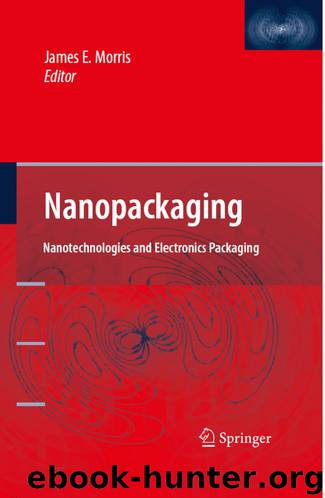Nanopackaging by James E. Morris

Author:James E. Morris
Language: eng
Format: epub
Publisher: Springer US, Boston, MA
For 3D ink-jet printing, the continuous system seems to be better [14]. In the drop-on-demand technique, there is no external backpressure in the fluid since surface tension is used to hold the fluid inside the orifice. Without external pressure, the DOD process has a limited throw distance (less than 10 mm), which limits its ability to control the trajectory of droplets. In the case of continuous ink-jet technology, the ink droplets travel a relatively long distance (100 mm) before being deposited onto the substrate. Additionally, through the use of electrostatic forces, CIJ systems are inherently designed to control the movement of droplets once they leave the printing head nozzle, which allows greater flexibility when printing in 3D space.
Besides the two basic technologies presented earlier, there are new systems developed, which allow arrangements of dots with a smaller size, higher repeatability, and better quality of printing. There is a system that is able to print dots in the range of 1 μm [29].
The electrical field, without the deflection system (as in the CIJ system), may also be helpful for microline printing. When a liquid is supplied to a nozzle and the interface between air and the liquid is charged to a sufficiently high electrical potential (∼kV), the liquid meniscus takes the form of a stable cone, whose summit emits a microscopic jet. This is referred to as the cone-jet mode in electrospray. In the system, the diameter of the nozzle used (above 100 μm) can be larger than that in standard ink-jet printing. The use of a larger nozzle prevents its clogging and allows easier processing of a viscous suspension containing a high level of solid particles [30]. Using an ink containing nano-Ag with the average diameter of 3–7 nm, lines as fine as 32 μm in width and 0.3 μm in thickness were printed. The line resistivity was about 13 × 10−6 Ω cm.
Active alignment control makes printing more precise. The system consists of nozzles, image sensors, and a target tracking system. Each nozzle is integrated with a microlens for an image sensor and a pair of electrodes to control ink jets according to the output of the image processing. The performance of the target detecting system was accurate enough to obtain 5-μm precision alignment. The fabricated nozzles achieved the patterning of Ag nanoparticles, which can be used as conductive wires after sintering. The width of the pattern was less than 20 μm with errors less than 3 μm [31].
Download
This site does not store any files on its server. We only index and link to content provided by other sites. Please contact the content providers to delete copyright contents if any and email us, we'll remove relevant links or contents immediately.
| Automotive | Engineering |
| Transportation |
Whiskies Galore by Ian Buxton(41935)
Introduction to Aircraft Design (Cambridge Aerospace Series) by John P. Fielding(33085)
Small Unmanned Fixed-wing Aircraft Design by Andrew J. Keane Andras Sobester James P. Scanlan & András Sóbester & James P. Scanlan(32763)
Craft Beer for the Homebrewer by Michael Agnew(18194)
Turbulence by E. J. Noyes(7977)
The Complete Stick Figure Physics Tutorials by Allen Sarah(7334)
Kaplan MCAT General Chemistry Review by Kaplan(6896)
The Thirst by Nesbo Jo(6877)
Bad Blood by John Carreyrou(6580)
Modelling of Convective Heat and Mass Transfer in Rotating Flows by Igor V. Shevchuk(6406)
Learning SQL by Alan Beaulieu(6235)
Weapons of Math Destruction by Cathy O'Neil(6206)
Man-made Catastrophes and Risk Information Concealment by Dmitry Chernov & Didier Sornette(5951)
Digital Minimalism by Cal Newport;(5699)
Life 3.0: Being Human in the Age of Artificial Intelligence by Tegmark Max(5506)
iGen by Jean M. Twenge(5384)
Secrets of Antigravity Propulsion: Tesla, UFOs, and Classified Aerospace Technology by Ph.D. Paul A. Laviolette(5330)
Design of Trajectory Optimization Approach for Space Maneuver Vehicle Skip Entry Problems by Runqi Chai & Al Savvaris & Antonios Tsourdos & Senchun Chai(5036)
Pale Blue Dot by Carl Sagan(4949)
